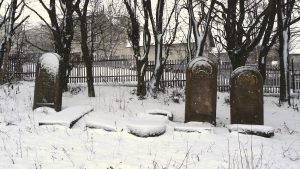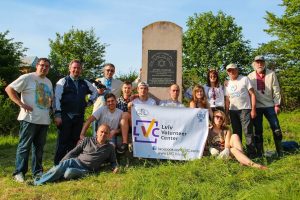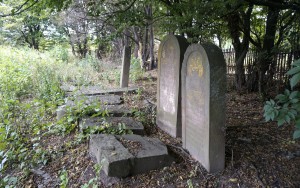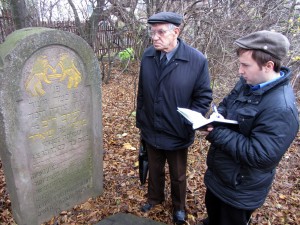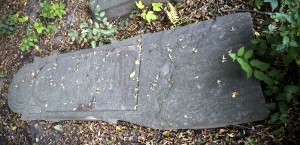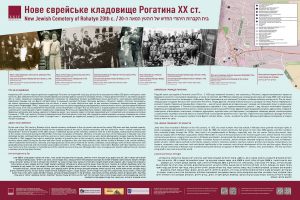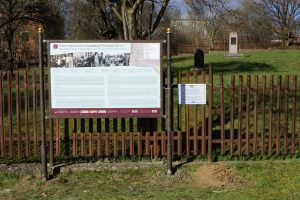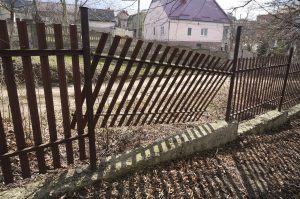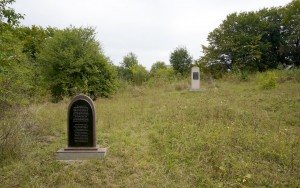![]() Ця сторінка також доступна українською.
Ця сторінка також доступна українською.
Introduction
Our heritage page about the second (or ‘new’) Jewish cemetery in Rohatyn notes that the site is acknowledged and preserved by the city in its original purpose as a burial place, but its connection with the city as a place of memory is much diminished due to its distance from the city center, significant destruction at the site during the Shoah, and indifference during the Soviet era. Denuded of most of its carved and inscribed burial markers, the family and community stories once written in stone there are today largely lost.
Read about the history and heritage of Rohatyn’s Jewish cemeteries.
Browse our news articles for coverage of events related to this project.
In our article on Jewish traditions for death, burial, and mourning, we note that in Jewish law, a cemetery is a holy place more sacred even than a synagogue, and that the care of cemeteries is an essential religious and social responsibility. Care of the new Jewish cemetery in Rohatyn is a primary concern of Rohatyn Jewish Heritage. Residents of Rohatyn respect all burial sites, but with no living local Jewish community in Rohatyn today, there are few nearby resources available for care on the scale the site needs. The size of the cemetery (roughly 0.4 hectares, or about one acre) means that simple maintenance requires planning and ongoing effort, and major rehabilitation will require phased work and long-term resource allocation.
The goals of the New Jewish Cemetery Rehabilitation Project are to:
- clean and clear the cemetery of unwanted vegetation and refuse
- survey the site to document visible and hidden fixed memorial markers
- develop the landscape to reduce annual maintenance effort and cost
- conserve the surviving headstones and monuments; raise fallen headstones and provide them with secure support
- create and install directional signage to lead visitors to the site, and informational signage to explain the history and heritage
- create a place of respect and contemplation about the Jewish past of Rohatyn
As described below, progress has already been made on this project, beginning with volunteer cleaning and clearing events in each year since 2017. As for our other projects, all RJH efforts will proceed with the continuing involvement of the Rohatyn city office and the office of the Rabbi of Ivano-Frankivsk.
Site Clearing, Cleaning, and Reconditioning
Clearing and cleaning the cemetery grounds is currently a primary component of the project; it aids in the assessment of soil conditions, in locating fixed and loose headstones and fragments, and in retarding decay of the site. Clearing and cleaning focuses on the removal of unwanted fast-growing and woody shrubs and trees, as well as the removal of accumulations of debris such as glass, metal, plastic, loose rocks, and garbage. In the first years of the project, the clearing process has revealed hidden surviving headstones, grave surrounds, and the base stumps of broken headstones.
The first two volunteer events to begin clearing the new cemetery of wild-growing brush, small trees, and grass were conducted by Rohatyn Jewish Heritage in spring 2017 with significant support of the Lviv Volunteer Center (LVC), in preparation for the ground-penetrating radar (GPR) survey which followed soon after. Another major clearing event, again by RJH with intense support from the LVC, took place in the summer of 2018; during that effort, heavy machinery was used to cut and clear dead tree limbs and a huge bramble of dangerous thorn bushes, in addition to the fast-growing brush and weeds which had returned after only a year. Then again in spring of 2019, the LVC returned to join RJH and other volunteers for a full day of clearing work, which removed much of the growth from the early growing season. Progressively, the harder unwanted plant materials in the cemetery are being removed: stumps of woody shrubs, dead tree limbs, dried thorn bushes, etc.; this makes annual clearing work easier, as more of that work can be accomplished more quickly with motorized string trimmers. Hand and power tools used in this work over the past years are shared from the Old Jewish Cemetery Rehabilitation Project. Current site clearing labor is transitioning here as for the old cemetery to local men hired by RJH in Rohatyn, which we hope will be a working strategy for the long term.
Site Survey of Existing Fixed Markers and Memorials
Following one of the clearing and cleaning events, and before significant conservation the new cemetery’s heritage objects, a site survey will be performed to geo-locate, index, and document each of the existing fixed markers and memorials. This includes headstones from burials before World War II, the memorial monument created and installed in the 1990s, and the memorial marker erected in 2015 by Rohatyn Jewish Heritage and Jewish descendants over the collection of human remains laid to rest in the cemetery a year earlier. Information from this survey will be used in the planning for matzevot conservation and for the addition of signage.
Only three fixed and complete headstones currently stand in the cemetery, all of them large and very heavy. Another several headstones of various sizes are fallen but appear intact and could likely be raised for re-installation. A small group of less than a dozen fragments cannot be re-erected, so will require tagging and separate treatment, like the hundreds of headstone fragments recovered to the old Jewish cemetery in Rohatyn. An unknown number of headstone stumps remaining from the desecration of the cemetery during and after World War II also need to be geo-located; some information about this may come from analysis of the 2017 GPR survey of the cemetery (originally intended to search for one or more possible mass graves at the site). During the site survey, other fixed features of the cemetery (fences, gate, retaining walls, platforms, utility pass-throughs, etc.) will also be geo-located and assessed for integrity and maintenance requirements.
Although the total number of inscribed headstones in the new cemetery is small, data from each of the stones will be incorporated into the database of all matzevot in Rohatyn, both fixed and loose, and both complete and fragmentary.
Conservation of Existing Markers
As a general rehabilitation action, all of the fixed and fallen headstones, whether intact or fragmentary, will be cleaned and treated under guidance from stone conservation experts; lessons learned in 2019 and 2020 for application at the old Jewish cemetery will be applied to the smaller number of stones in the new cemetery.
In addition, Rohatyn Jewish Heritage aims to erect matzevot which were uprooted in the cemetery but not removed during World War II, where it is possible for us to do that; several headstones are candidates for this heavy work. We hope to learn from and lean on the experience of expert cemetery rehabilitation organizations in central Europe, such as the Stowarzyszenie Magurycz (Magurycz Association) of Poland, now with almost two decades of experience in rescue and rehabilitation of headstones in distressed cemeteries of all faiths in Poland and Ukraine, especially those where the original community was displaced or destroyed and no local members are able to care for the stones and grounds. It may never be possible to determine where some of these displaced headstones once stood in the cemetery; about this issue, we will seek the advice of the Rabbi of Ivano-Frankivsk.
Directional and Information Signage
The new Jewish cemetery rehabilitation project includes sign installations to direct visitors to the site, to identify the site and its purpose, and to inform visitors about the history of the cemetery, about the Jewish community of Rohatyn, and about the valuable cultural resource carved into the surviving headstones.
Directional pedestrian signs: At the beginning of 2021, the Rohatyn Opillya Museum of regional history led a project for the City of Rohatyn to design and install signs on city streets and at the town square directing pedestrians to sites of local heritage, including three of the Jewish burial sites: the old cemetery and both Holocaust mass grave sites. In addition, a large tourist map installed at Roksolana Square in the city center shows all four burial sites (including the new Jewish cemetery). A tourist brochure available at the Opillya Museum and at City Hall duplicates the heritage features map and can guide visitors to all of the sites as well as parks, bus stations, and other helpful city services.
Informational sign – cemetery/community: A memorial stele near the center of the cemetery includes very brief remarks about the Jews of Rohatyn; a smaller one nearby commemorates the unknown dead whose remains were found under the Ukrainian Greek Catholic church building in 2012. Otherwise there is no historical information available at the cemetery about the site or the Jewish community which established and used it. Visitors to Rohatyn who are interested in the local heritage may learn more about the the town’s Jewish history at the local history museum “Opillya” (1.5km away) and of course “virtually” on this website, but only some of the people who find and enter the old cemetery will use those resources, and there is no better place to explain the cemetery than at the site itself.
In spring of 2023 a medium-sized information sign was installed outside the cemetery perimeter to encourage visitors to enter. The sign is sized to present enough information for visitors to help them understand the site in historical and geographical context. The sign panel is nominally 1.5m wide by 1.0m high (about 60in. by 40in.) with these features:
- three languages: Ukrainian (primary), English, Hebrew
- a history of the Rohatyn Jewish community
- photos of Rohatyn Jews in the interwar period
- a history of the cemetery
- QR code links to history and heritage pages on this website
- acknowledgment to descendants and supporters of the project
- a map of Jewish and other heritage sites in Rohatyn, with a key
- plastic printed film laminated to a formed steel sheet and supported by two steel poles embedded in concrete at the base
The design of the information sign is shown here at reduced resolution (due to file size); the full printed image is created at 300dpi.
RJH researched and wrote historical text in English for the sign, and created the map of Rohatyn Jewish heritage sites. Translations were contributed by long-time supporters Natalia Kurishko (to Ukrainian) and Rohatyn descendant Ruthy Erez (to Hebrew); historical photographs were provided by several Rohatyn Jewish descendants and by historical image collectors. For the design and fabrication of the sign, RJH partnered with ESJF European Jewish Cemeteries Initiative (Alexandra Fishel, Alex Bessarab, Philip Carmel) so that the sign met the high standards which they have been applying at many installations in Ukraine and other countries where ESJF has fenced Jewish cemeteries. The original sign concept and installation location were reviewed and approved by the Rohatyn city administration prior to fabrication, and we thank both the Rohatyn City administration and the local history museum «Opillya» for their support.
.
Fence and Gate Repair (or Replacement)
The existing steel picket fence surrounding the new cemetery was installed at least two decades ago, and has begun decaying; some sections are missing, and the gate is losing strength. However, the fence still serves its primary purpose, to visually mark the cemetery boundaries, and we are gradually repairing what we can of the existing fence.
It is important to our goal of re-integrating the cemetery into the cultural fabric of the city that the fence remains visually open, the gate remains unlocked, and the cemetery itself becomes more inviting to visitors. Our efforts to clear the cemetery grounds of overgrown wild vegetation includes cutting back unwanted aggressive shrubs at the fence, plus annual maintenance to inhibit those shrubs’ return, while retaining several of the decorative trees and hedges which have appeared along the fence in the last decades – all intended to improve visibility inward to the cemetery and outward to the surrounding neighborhood and the city.
Eventually the fence will require replacement, but we hope that the existing fence can continue to serve its primary purpose for years to come.
Maintenance
In the absence of a formal plan to replant the new cemetery with slow-growing and dense ground cover to minimize annual maintenance of the grounds, repeated annual care in the form of inspection, clearing, cleaning, and minor repair work as described above will be required, and Rohatyn Jewish Heritage anticipates sharing this responsibility with the City of Rohatyn (which owns the property). RJH visits the new cemetery typically 18 to 20 times per year, sometimes working for entire days at the site, and we anticipate that will continue until other project progress allows us to consider major landscaping changes at the new cemetery.
Project Costs
Project costs for care of the new Jewish cemetery heritage site are currently limited to maintenance expenses, and generally shared with expenses for care of the old cemetery (tools, supplies, and repairs). A summary of the investment and recurring costs incurred by Rohatyn Jewish Heritage for equipment and materials for cemetery maintenance, and the sources of funds to pay those costs, are included in RJH annual reports (see the News section of this website).

